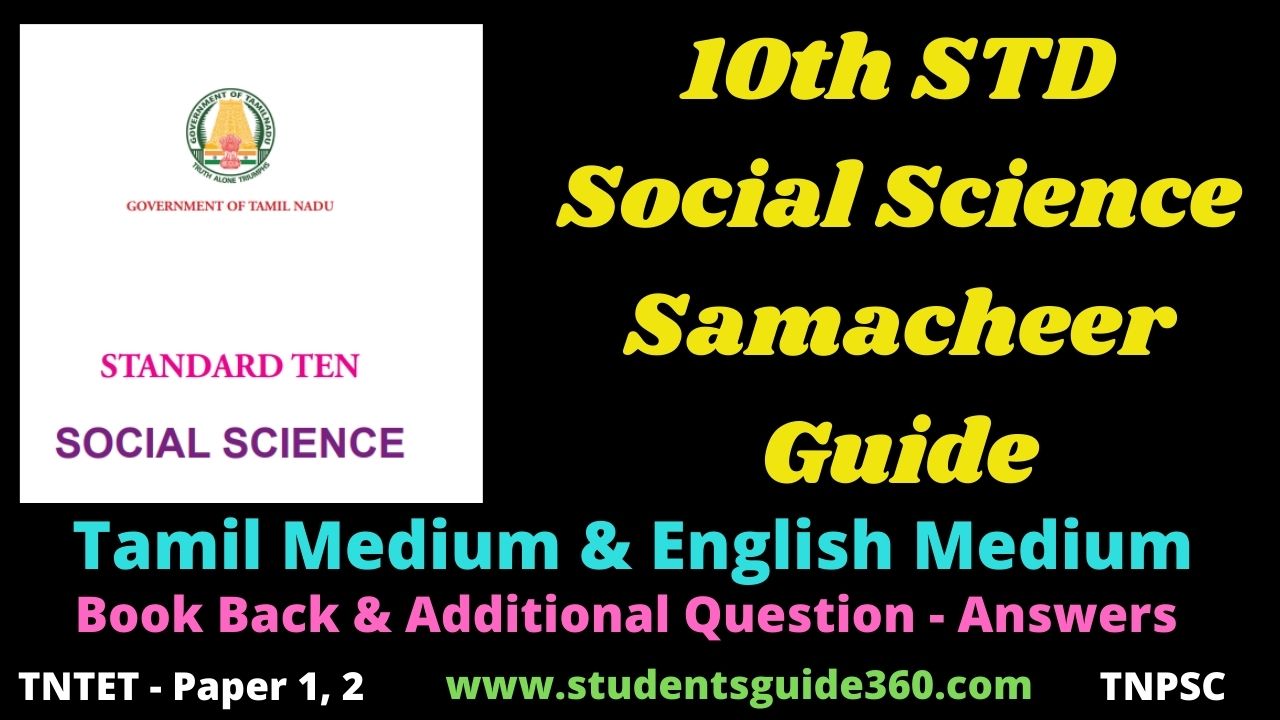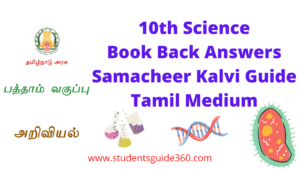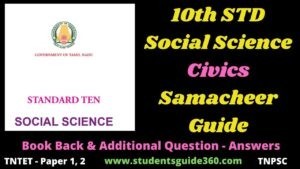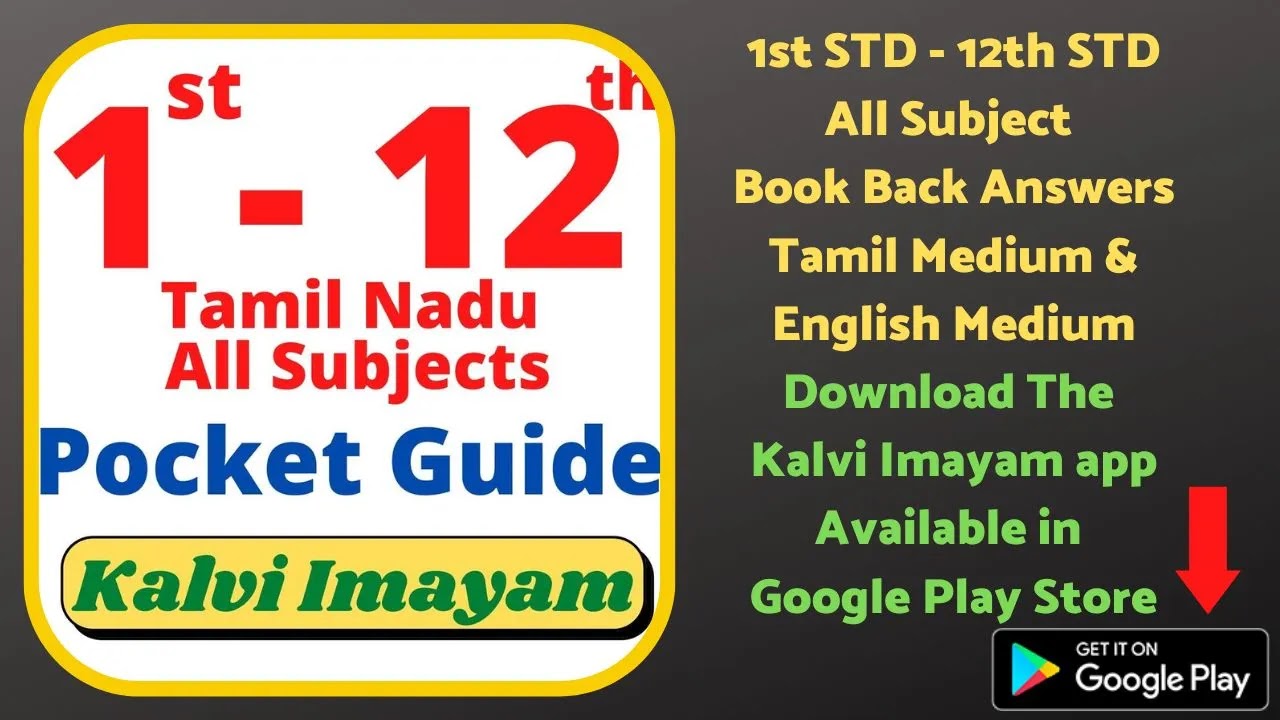10th Social Science Guide Geography – Resources and Industries
10th Standard Social Science Solution | Lesson.14 India – Resources and Industries
10th Social Science Guide Geography – Resources and Industries. 10th Social Science Guide Geography Unit 4 Answers. 10th Standard Social Science Solution | Geography – Resources and Industries. SSLC Social Science Book Back Answers English Medium. Class 10 History, Geography, Civics, Economics Full Answers Both School Students, TNTET, TRB, TNPSC, etc… Applicable to everyone preparing for the exam. TN Samacheer Kalvi Guide for 10th Standard. Tamil Nadu State Board Samacheer Kalvi 10th Social Science Book Answers Solutions Guide Pdf Free Download in English Medium and Tamil Medium are part of Samacheer Kalvi 10th Books Solutions.
TN State Board New Syllabus Samacheer Kalvi 10th Std Social Science Guide Text Book Back Questions and Answers all units 10th Social Science Model Question Papers 2020-2021 English & Tamil Medium. We Update TN State Board Syllabus Guide All Classes Guide, Answers https://www.studentsguide360.com/
- 10th Social Science – History Guide – Click Here
- 10th Social Science All units Tamil Medium Guide – Click Here
- 10th Social Science All units English Medium Guide – Click Here
Lesson.14 India – Resources and Industries
I. Choose the Correct Answer:
1. Manganese is used in ________.
- Storage batteries
- Steel Making
- Copper smelting
- Petroleum Refining
Ans : Steel making
2. The Anthracite coal has ________.
- 80 to 95% Carbon
- Above 70% Carbon
- 60 to 70% Carbon
- Below 50% Carbon
Ans : 80 to 95% coal
3. The most important constituents of petroleum are hydrogen and
- Oxygen
- Water
- Carbon
- Nitrogen
Ans : Nitrogen
4. The city which is called as the Manchester of South India is
- Chennai
- Salem
- Madurai
- Coimbatore
Ans : Coimbatore
5. The first Nuclear Power station was commissioned in
- Gujarat
- Rajasthan
- Maharashtra
- Tamil nadu
Ans : Maharashtra
6. The most abundant source of energy is
- Bio mass
- Sun
- Coal
- Oil
Ans : Sun
7. The famous Sindri Fertilizer Plant is located in
- Jharkhand
- Bihar
- Rajasthan
- Assam
Ans : Jharkhand
8. The nucleus for the development of the chotanagpur plateau region is
- Transport
- Mineral Deposits
- Large demand
- Power Availability
Ans : Mineral deposits
II. Match the following:
- Bauxite – Cement
- Gypsum – Aircraft
- Black Gold – Electrical goods
- Iron ore – Coal
- Mica – Magnetite
Ans : 1 – B, 2 – A, 3 – D, 4 – E, 5 – C
III. Answer the following Questions briefly
1. Define the resource and state its types.
- Any matter or energy derived from the environment that is used by living things including humans is called a natural resource.
- The two types of resources are Renewable resources and Non – renewable resources.
2. What are the minerals and its types?
- Mineral is a natural substance of organic or inorganic origin with definite chemical and physical properties.
- Minerals are broadly grouped under two categories. They are metallic and non – metallic minerals.
3. State the uses of magnesium.
- It is used for making iron and steel.
- It serves as basic raw material for alloying.
- It is also used in the manufacturing of bleaching powder, insecticides, paints and batteries.
4. What is natural gas?
- It is naturally occurring hydro carbon gas mixture consisting primarily of methane, but commonly includes varying amounts of other higher alkanes. Sometimes it includes a small percentage of carbon dioxide, nitrogen and hydrogen sulphide.
- It is formed when layers of decomposed plants and animals are exposed to intense heat and pressure over thousands of years.
5. Name the different types of coal with their carbon content.
Based on carbon content, coal is classified into the following type.
Anthracite Contains 80 to 90% carbon
Bituminous Contains 60 to 80% carbon
Lignite Contains 40 to 60% carbon
Peat Contains less than 40% carbon
6. Mention the major areas of jute production in India.
- The major jute producing areas are in West Bengal and is concentrated along the Hooghly river.
- Andhra Pradesh, Bihar, Uttra Pradesh, Assam, Chhattisgarh and Odisha are the other jute goods producing are as.
7. Name the important oil producing regions of India.
- Mumbai high oil fields.
- Gujarat coast
- Basseim oil field
- Aliabet oil field
- Ankleshwar
- Cambay – Lumu region
- Ahmedabad – Kalol region
IV Distinguish between
1. Renewable and non-renewable resources.
Renewable resources:
- Renewable resources are the resources that can be regenerated after their utilisation.
- The time taken to renew differs from one resource to another.
- Eg: Solar energy, Wind energy, Tidal energy, Bio gas, Wave energy, etc.
Non-Renewable resources:
- Non–renewable resources are the resources that cannot be replaced again after utilisation.
- They are formed over a long geological periods.
- Eg: Coal, Petroleum, Natural gas, etc.
2. Metallic and non-metallic minerals.
Metallic Minerals
- Metallic minerals contain one or more metallic elements in them.
- Tron, Manganese, Copper, Bauxite, Nickel, Zinc, Lead, Gold, etc are the metallic minerals.
Non – metallic minerals
- Non–metallic minerals do not contain metals in them.
- Mica, Limestone, Gypsum, Nitrate, Potash, dolomite, Coal, Petroleum, etc are the non – metallic minerals.
3. Agro based industry and mineral based industry.
Agro Based Industry
- Agro based industries draw their raw materials from agricultural sector.
- The major agro based industry of the country is Cotton Textile industry.
- Jute textiles and sugar industries are other agrobased industries.
- These industries are located near the area of raw materials cultivation.
Mineral Based Industries.
- Mineral based industries use both metallic and non metallic minerals as raw materials.
- The major mineral based industry of country is the Iron and Steel industry.
- Cement industries and automobile industries are other mineral based industries.
- These industries are located nearer to the areas where minerals are mixed.
4. Jute industry and sugar industry.
Jute Industry
- Jute is the raw material for jute industry
- India is the largest producer of jute goods in the world.
- This is the second important textile industry in India after cotton textiles.
- The major jute producing state in India is West Bengal
Sugar Industry
- Sugarcane is the raw material for sugar industry
- India is the second largest producer of sugarcane in the world
- This is the second largest agro based industry in India after cotton industry.
- The major sugar producing state in India is Uttar Pradesh.
5. Conventional energy and non- conventional energy.
Conventional Energy
- 1. It includes Thermal power and Nuclear power.
- 2. Conventional energy sources are non-renewable.
- 3. It pollutes the atmosphere.
- 4 Coal, petroleum and natural gas are sources of conventional energy.
Non Conventional Energy
- 1. It includes Hydropower, Solar energy, wind energy, tidal energy, wave energy etc.
- 2. Non-conventional energy sources are renewable.
It does not pollute the atmosphere - 3. Water, sun-light and wind are sources of non-conventional energy.
V Answer the following in a paragraph
1. Write about the distribution of cotton textile industries in India.
- Textile is a broad term which includes cotton, jute, wool, silk and synthetic fibre textiles.
- This sector in India has 3400 textiles mills with installed capacity of more than 50 million spindles.
- Traditional sectors like handloom, handicrafts and small power loom units are the biggest sources of employment.
- It is one of the sources of employment generation in our country.
- Currently, India is the third largest producer of cotton and has the largest loom are and ring spindles in the world.
- At present, cotton textile industry is the largest organised modern industry of India.
- The highest concentration of textile mills in and around Mumbai, makes it as ‘Manchester of India’.
- The major cotton textile industries are concentrated in the states of Maharashtra, Gujarat, West Bengal, Uttar Pradesh and Tamil Nadu.
- Coimbatore is the most important centre in Tamil Nadu with 200 mills out of its 435 and hence called as “Manchester of South India”.
- Erode, Tirupur, Karur, Chennai, Tirunelveli, Madurai, Thoothukudi, Salem and Virudhunagar are the other major cotton textile centres in the state.
2. Describe the major challenges of Indian industries.






